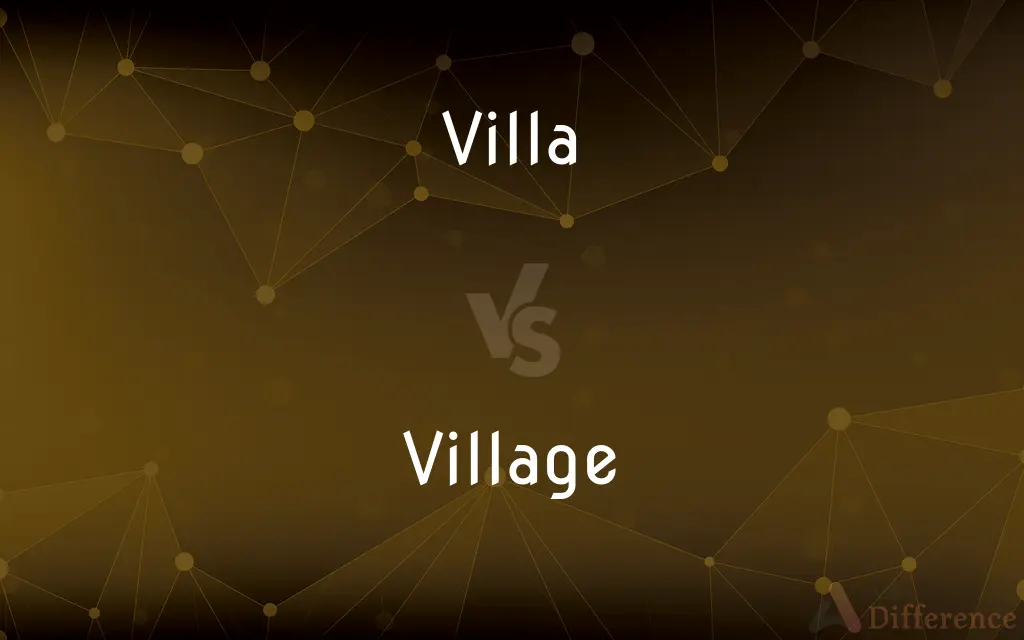Villa vs. Village — What's the Difference?
By Tayyaba Rehman & Maham Liaqat — Updated on March 2, 2024
A villa is a large and luxurious country house, often with its own grounds and gardens, while a village is a small community or settlement with residential houses and other amenities like shops and schools.

Difference Between Villa and Village
Table of Contents
ADVERTISEMENT
Key Differences
A villa typically refers to a single, often luxurious dwelling, situated usually in the countryside or near the coast, designed for comfort and privacy. It can serve as a primary residence or a vacation home, characterized by spacious living areas, gardens, and sometimes, private pools. Whereas a village comprises multiple dwellings, forming a small community that includes not just homes but also communal facilities such as local markets, schools, and places of worship, indicating a social and economic structure.
Villas are primarily residential and are designed to cater to the living standards of individuals or families seeking comfort and exclusivity. On the other hand, villages are not just residential areas but also social entities, where the residents share resources, traditions, and a sense of belonging, reflecting a collective lifestyle.
While the concept of a villa is often associated with luxury and leisure, focusing on architectural design, privacy, and amenities for individual enjoyment, a village emphasizes community life, where interactions among residents play a crucial role in daily life. Villages also support local economies through agriculture, small businesses, and trades.
Ownership and access distinguish a villa from a village; a villa is typically owned by an individual or a family, offering private amenities. In contrast, a village consists of many properties, public spaces, and shared resources, accessible to all residents and governed by local authorities or community organizations.
The cultural and historical significance can also vary; villas may be valued for their architectural beauty, historical importance, or as symbols of wealth and status. Villages, however, are often appreciated for their cultural heritage, traditions, and the sense of community they foster, playing a vital role in the rural landscape and in preserving traditional ways of life.
ADVERTISEMENT
Comparison Chart
Definition
A luxurious country house
A small community or settlement
Primary Function
Residential comfort and privacy
Residential and communal living
Features
Luxurious amenities, gardens, privacy
Local markets, schools, communal facilities
Ownership
Individual or family
Multiple homeowners and public spaces
Focus
Architectural design, luxury
Community life, local economy
Significance
Wealth, status, architecture
Cultural heritage, traditions
Location
Countryside or coastal areas
Rural or semi-rural areas
Population
Limited to occupants
Larger, community-based population
Economic Structure
Not applicable
Supported by agriculture, small businesses
Compare with Definitions
Villa
A luxurious country home.
The family spent their summer in a Mediterranean villa.
Village
Supports a local economy.
Village markets provide fresh, locally-sourced produce.
Villa
Private residence with amenities.
Their villa boasted a private pool and extensive gardens.
Village
A small community settlement.
The village was known for its annual festival.
Villa
Designed for comfort and exclusivity.
The villa offered breathtaking views and unparalleled privacy.
Village
Features communal facilities.
The village's central square was a hub of activity.
Villa
Symbol of wealth and leisure.
The ancient Roman villas were centers of estate management.
Village
Emphasizes shared traditions.
Villagers gather yearly to celebrate their cultural heritage.
Villa
Often a vacation home.
They rented a villa by the sea for their holiday.
Village
Governed by local or community authorities.
The village council decided on the new community project.
Villa
A villa is a type of house that was originally an ancient Roman upper-class country house. Since its origins in the Roman villa, the idea and function of a villa has evolved considerably.
Village
A village is a clustered human settlement or community, larger than a hamlet but smaller than a town (although the word is often used to describe both hamlets and smaller towns), with a population typically ranging from a few hundred to a few thousand. Though villages are often located in rural areas, the term urban village is also applied to certain urban neighborhoods.
Villa
(especially in continental Europe) a large and luxurious country house in its own grounds.
Village
A small group of dwellings in a rural area, usually ranking in size between a hamlet and a town.
Villa
A large country house of Roman times, having an estate and consisting of farm and residential buildings arranged around a courtyard.
Village
A rural habitation of size between a hamlet and a town.
There are 2 churches and 3 shops in our village.
Villa
The often large, luxurious country house of a well-to-do person.
Village
A small assemblage of houses in the country, less than a town or city.
Villa
A country house, with farm buildings around a courtyard.
Village
A community of people smaller than a town
Villa
Country house in ancient Rome consisting of residential quarters and farm buildings around a courtyard
Villa
Pretentious and luxurious country residence with extensive grounds
Common Curiosities
How do villages support local economies?
Through agriculture, small businesses, crafts, and local trades, villages can sustain their economies and support residents.
Can a villa be part of a village?
Yes, a villa can be located within a village, but it remains a distinct, privately owned property amidst the broader community.
What distinguishes a villa from a village?
A villa is a single luxurious residence, while a village is a small community with multiple dwellings and shared amenities.
What is the primary focus of a village?
The primary focus is on community life, shared resources, and local economy.
Are villas only found in rural areas?
While traditionally rural, modern villas can also be found in suburban or even urban settings, depending on their design and purpose.
How does community life in a village differ from urban living?
Village life often involves closer social connections, shared traditions, and a greater reliance on local resources, contrasting with the more anonymous and resource-diverse urban living.
Is a villa always a sign of luxury?
Typically, yes, villas are designed for luxury and comfort, but the term can sometimes be used more broadly for any detached house, especially in different cultural contexts.
What role do villages play in cultural preservation?
Villages often maintain cultural traditions, dialects, festivals, and social practices that are integral to regional or national heritage.
Can the concept of a village vary globally?
Yes, the size, structure, and cultural significance of villages can vary widely across different countries and cultures.
What amenities might a villa have?
Amenities can include private gardens, pools, spacious interiors, and often, sophisticated security and technology systems.
Share Your Discovery

Previous Comparison
Consolable vs. Consoling
Next Comparison
Clerk vs. StenographerAuthor Spotlight
Written by
Tayyaba RehmanTayyaba Rehman is a distinguished writer, currently serving as a primary contributor to askdifference.com. As a researcher in semantics and etymology, Tayyaba's passion for the complexity of languages and their distinctions has found a perfect home on the platform. Tayyaba delves into the intricacies of language, distinguishing between commonly confused words and phrases, thereby providing clarity for readers worldwide.
Co-written by
Maham Liaqat















































